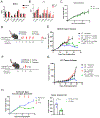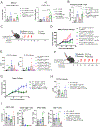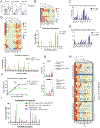FLT3L Release by Natural Killer Cells Enhances Response to Radioimmunotherapy in Preclinical Models of HNSCC
- PMID: 34518311
- PMCID: PMC8595694
- DOI: 10.1158/1078-0432.CCR-21-0971
FLT3L Release by Natural Killer Cells Enhances Response to Radioimmunotherapy in Preclinical Models of HNSCC
Abstract
Purpose: Natural killer (NK) cells are type I innate lymphoid cells that are known for their role in killing virally infected cells or cancer cells through direct cytotoxicity. In addition to direct tumor cell killing, NK cells are known to play fundamental roles in the tumor microenvironment through secretion of key cytokines, such as FMS-like tyrosine kinase 3 ligand (FLT3L). Although radiotherapy is the mainstay treatment in most cancers, the role of radiotherapy on NK cells is not well characterized.
Experimental design: This study combines radiation, immunotherapies, genetic mouse models, and antibody depletion experiments to identify the role of NK cells in overcoming resistance to radiotherapy in orthotopic models of head and neck squamous cell carcinoma.
Results: We have found that NK cells are a crucial component in the development of an antitumor response, as depleting them removes efficacy of the previously successful combination treatment of radiotherapy, anti-CD25, and anti-CD137. However, in the absence of NK cells, the effect can be rescued through treatment with FLT3L. But neither radiotherapy with FLT3L therapy alone nor radiotherapy with anti-NKG2A yields any meaningful tumor growth delay. We also identify a role for IL2 in activating NK cells to secrete FLT3L. This activity, we show, is mediated through CD122, the intermediate affinity IL2 receptor, and can be targeted with anti-CD25 therapy.
Conclusions: These findings highlight the complexity of using radio-immunotherapies to activate NK cells within the tumor microenvironment, and the importance of NK cells in activating dendritic cells for increased tumor surveillance.
©2021 American Association for Cancer Research.
Conflict of interest statement
Figures






Similar articles
-
Down-regulation of HLA-B-associated transcript 3 impairs the tumoricidal effect of natural killer cells through promoting the T cell immunoglobulin and mucin domain-containing-3 signaling in a mouse head and neck squamous cell carcinoma model.Immunobiology. 2022 Jan;227(1):152127. doi: 10.1016/j.imbio.2021.152127. Epub 2021 Jul 30. Immunobiology. 2022. PMID: 34968777
-
Cetuximab therapy in head and neck cancer: immune modulation with interleukin-12 and other natural killer cell-activating cytokines.Surgery. 2012 Sep;152(3):431-40. doi: 10.1016/j.surg.2012.05.035. Epub 2012 Jul 6. Surgery. 2012. PMID: 22770960 Free PMC article.
-
Landscape of natural killer cell activity in head and neck squamous cell carcinoma.J Immunother Cancer. 2020 Dec;8(2):e001523. doi: 10.1136/jitc-2020-001523. J Immunother Cancer. 2020. PMID: 33428584 Free PMC article. Review.
-
Immuno-gene therapy with adenoviruses expressing fms-like tyrosine kinase 3 ligand and CD40 ligand for mouse hepatoma cells in vivo.Int J Oncol. 2003 Feb;22(2):345-51. Int J Oncol. 2003. PMID: 12527933
-
Combining radiotherapy and NK cell-based therapies: The time has come.Int Rev Cell Mol Biol. 2023;378:31-60. doi: 10.1016/bs.ircmb.2023.02.003. Epub 2023 Mar 24. Int Rev Cell Mol Biol. 2023. PMID: 37438020 Review.
Cited by
-
High FLT3 expression increases immune-cell infiltration in the tumor microenvironment and correlates with prolonged disease-free survival in patients with non-small cell lung cancer.Mol Oncol. 2024 May;18(5):1316-1326. doi: 10.1002/1878-0261.13597. Epub 2024 Feb 7. Mol Oncol. 2024. PMID: 38327131 Free PMC article.
-
Dichotomous effects of cellular expression of STAT3 on tumor growth of HNSCC.Mol Ther. 2022 Mar 2;30(3):1149-1162. doi: 10.1016/j.ymthe.2021.11.011. Epub 2021 Nov 15. Mol Ther. 2022. PMID: 34793974 Free PMC article.
-
Natural killer cell-related prognostic risk model predicts prognosis and treatment outcomes in triple-negative breast cancer.Front Immunol. 2023 Jul 13;14:1200282. doi: 10.3389/fimmu.2023.1200282. eCollection 2023. Front Immunol. 2023. PMID: 37520534 Free PMC article.
-
BCG immunotherapy promotes tumor-derived T-cell activation through the FLT3/FLT3LG pathway in bladder cancer.J Cancer. 2024 Jan 1;15(3):623-631. doi: 10.7150/jca.90085. eCollection 2024. J Cancer. 2024. PMID: 38213738 Free PMC article.
-
Natural killer cell-related prognosis signature characterizes immune landscape and predicts prognosis of HNSCC.Front Immunol. 2022 Oct 3;13:1018685. doi: 10.3389/fimmu.2022.1018685. eCollection 2022. Front Immunol. 2022. PMID: 36263048 Free PMC article.
References
-
- Oweida A, Hararah MK, Phan A, Binder D, Bhatia S, Lennon S, Bukkapatnam S, Van Court B, Uyanga N, Darragh L, et al. Resistance to radiotherapy and PD-L1 blockade is mediated by TIM-3 upregulation and regulatory T-cell infiltration. Clin Cancer Res (2018) 24:5368–5380. doi:10.1158/1078-0432.CCR-18-1038 - DOI - PMC - PubMed
Publication types
MeSH terms
Substances
Grants and funding
LinkOut - more resources
Full Text Sources
Other Literature Sources
Medical
Research Materials
Miscellaneous

